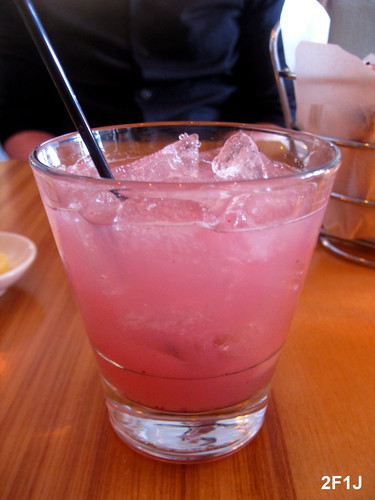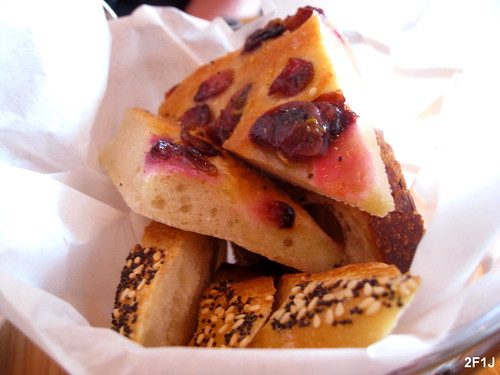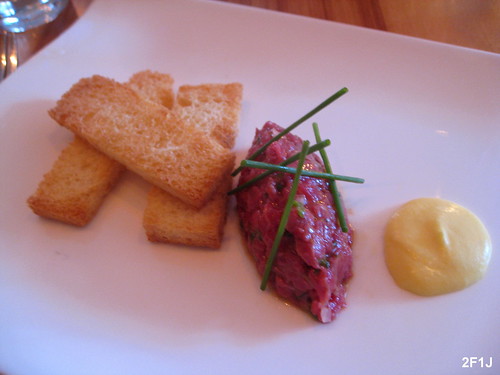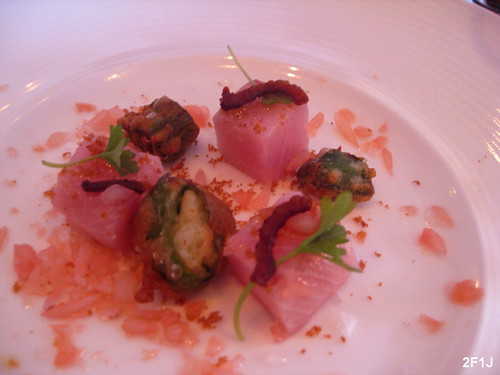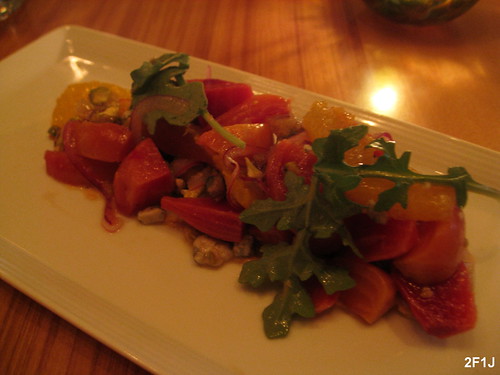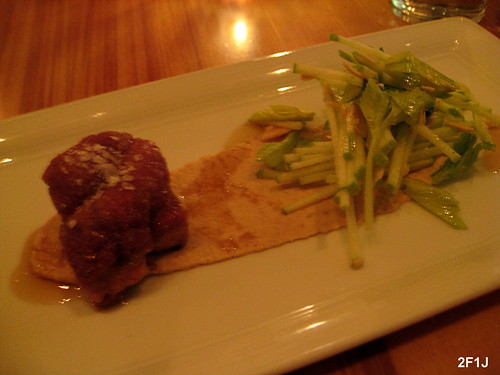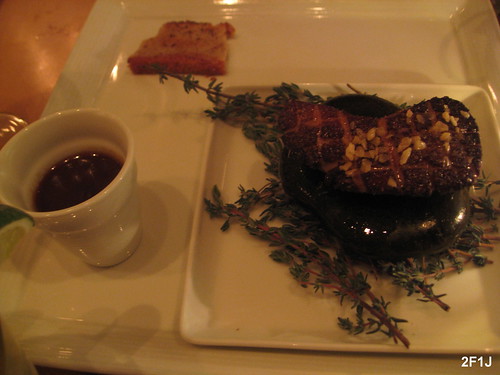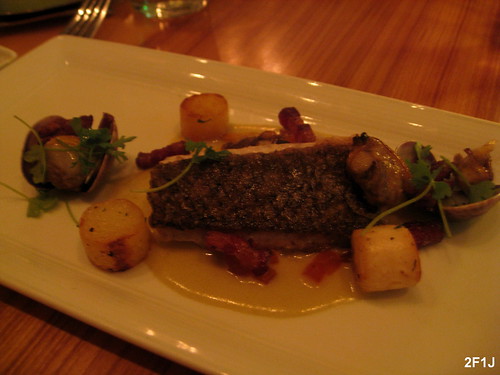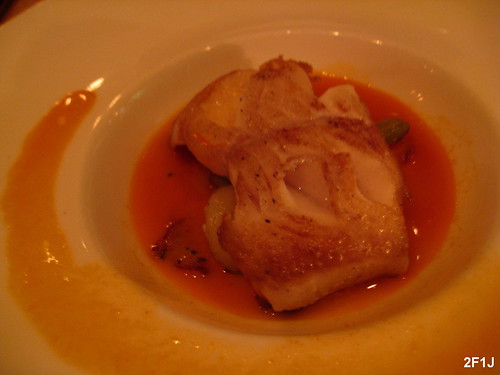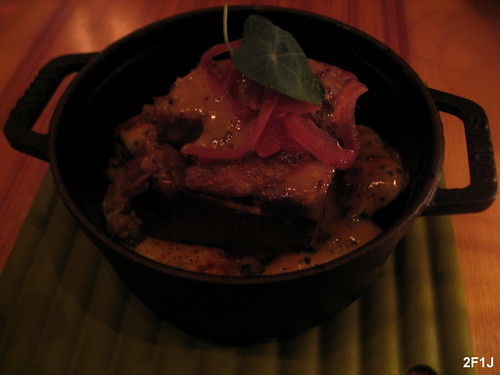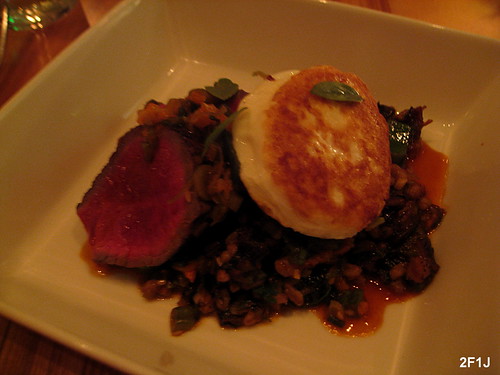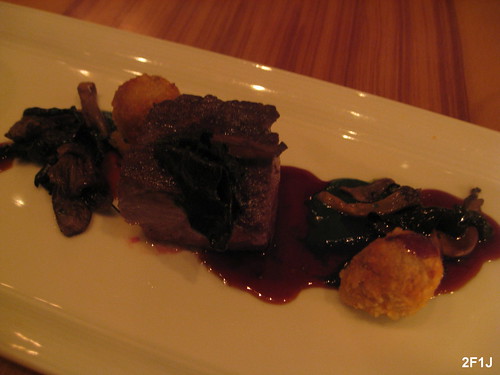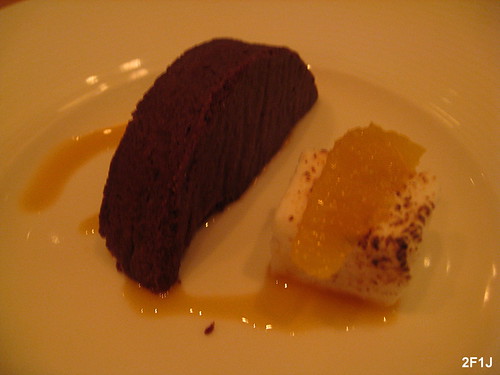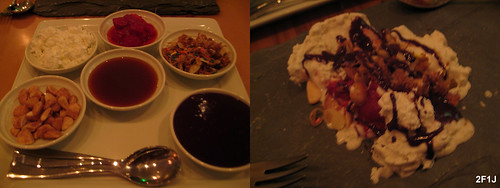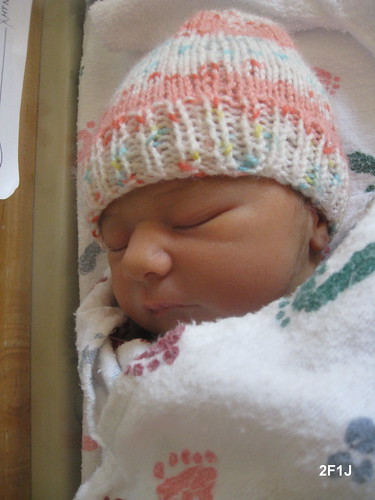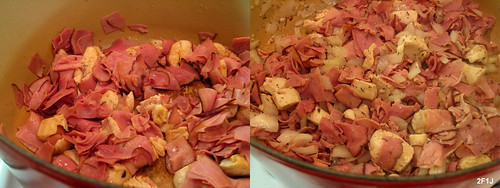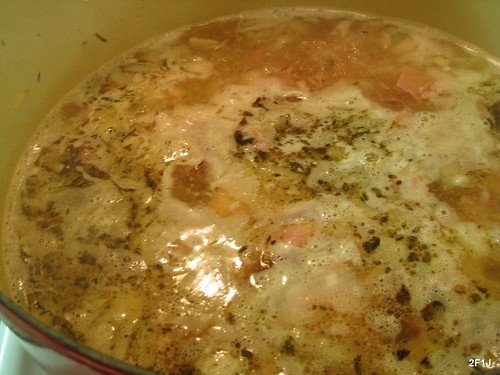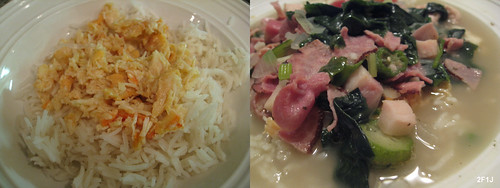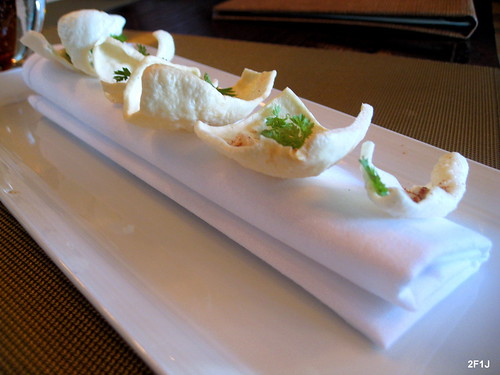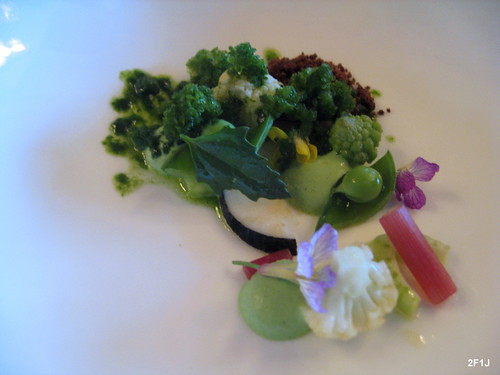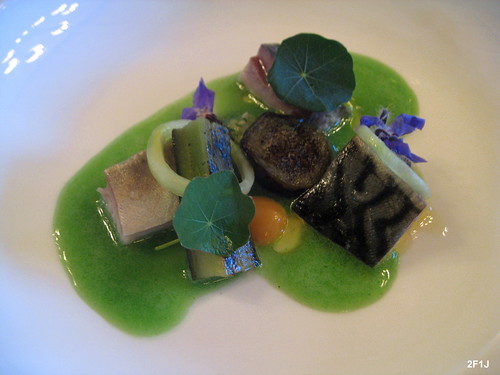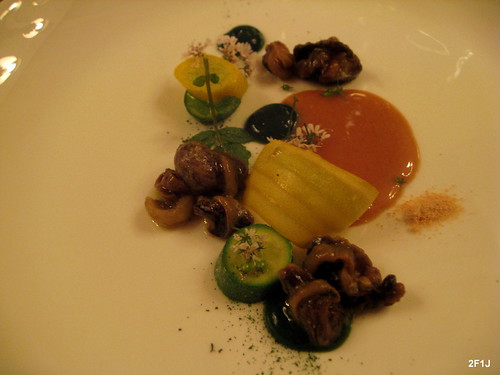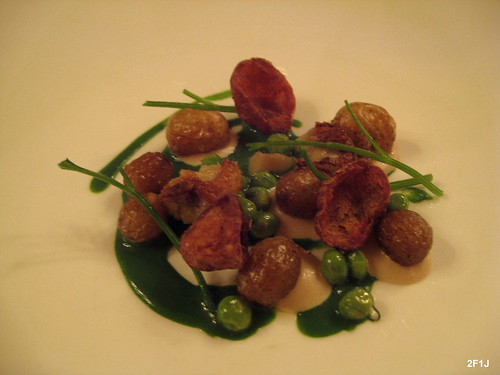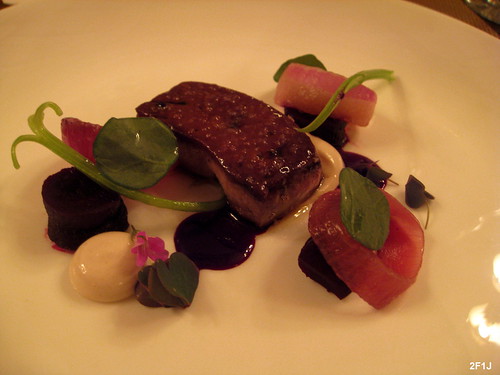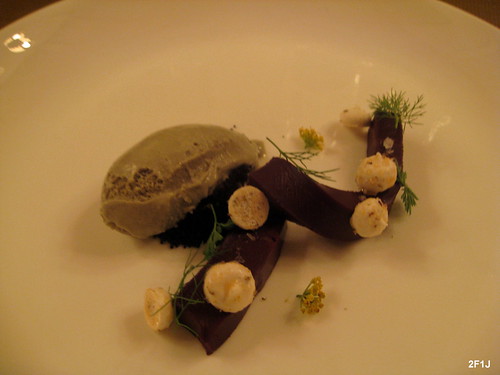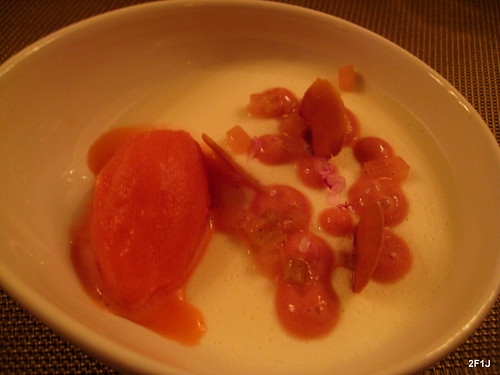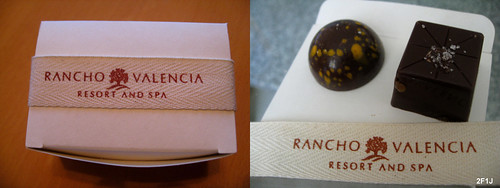Our interest in everything about food, cooking and
restaurants isn’t much of a secret to our co-workers and so it is not
surprising that often discussions at work center around these topics. One
question we are asked regularly is about the best restaurant and special memorable
meals. It is impossible to answer about “the” best restaurant as we like a
broad spectrum of restaurants ranging from small ethnic hole in the walls to high-end
upscale restaurants and it really depends on the occasion and mood which ones
we prefer on a given day. And so it is easier to just agree on general criteria
for a good restaurant – quality of food and service paired with a fitting
ambience. The more interesting question is about special memorable meals and how
they are defined for us. Even though we are not fixed on one particular cuisine
it became more apparent for us over the years that we truly remember and
discuss for a long time those dinners in restaurants which are trying to
combine unusual flavor and ingredient combinations far outside of what the
majority of restaurants are serving often incorporating modern techniques. Most
of the restaurants we enjoy most, like Bistro LQ, Saam or Coi are located in
Los Angeles and San Francisco. San Diego has a number of restaurants we have on
our heavy rotation list but for a long time none of them really belonged to the
list of restaurants for one of these memorable dinners. At the same time the background
and reputation of several chefs in San Diego is on par with their peers in LA
and San Francisco and so we often wondered if there are hidden gems in San
Diego we are missing. More recently we decided to focus on finding those unique
restaurants in San Diego and were quite happy to indeed find those special
places like Blanca under Gavin Schmidt and Rancho Valencia with Aaron Martinez.
Encouraged by these findings we decided recently to contact more restaurants in San Diego to discuss with several chefs if they would be interested in preparing special tasting menus without any limitations. One of the restaurants which was on the top of our list was Kitchen 1540 in the L’Auberge Hotel in Del Mar. The restaurant under Chef McCabe was our very first fine dining experience in San Diego several years ago when it was still named J. Taylor. But we still discuss today some of the dishes we had like a venison entrée or a dessert with a selection of different crème brulees. Paul McCabe, born in Arizona, started his culinary career as an apprentice under Chef Michel Blanchet at the L’Ermitage in Los Angeles. Over the next few years Chef McCabe held different positions with increasingly more responsibility at restaurants in California, Arizona and Hawaii including Sous Chef and Chef de Cuisine at the Enchantment Resort, Sous Chef at the L’Ermitage before in 2001 he finally settled in San Diego as Executive Chef at Top of the Cove. He moved in 2002 to the Star of the Sea before becoming Executive Chef at J.Taylor which after extensive renovation in 2008 reopened as Kitchen 1540.
After some email exchange with GM Bryan LaFontaine we finally settled on a 10-course White Flag Tasting Menu where we served up to ten courses but could “throw up the white flag at anytime we feel that we cannot eat anymore”.
Hibiscus Caipirinha: Leblon Cachaca, Domaine de Canton,
fresh lime, house made hibiscus syrup
We started the night with an interesting twist on this
classical Brazilian cocktail which got some refreshing floral notes from the
hibiscus syrup balanced by the ginger liqueur.
Bread Service: Kitchen 1540 serves several different breads for the bread service. Most of the selection is decent with the highlight of the grape-fleur de sel foccacia
Course 1A: Bison tartare, smoked bacon Sabayon, brioche,
chives
We had many different tartars so far covering beef or venison but this was the first time with bison. The bison had a surprisingly strong
and rich flavor with some subtle background notes from the mixed-in lemon oil. The
bacon sabayon added a complementing smoothness to this excellent dish.
Course 1B: Hamachi crudo, shishito peppers, grapefruit
supremes, shaved bottarga
We expected to get the same courses throughout the tasting
menu but were surprised when our server brought us two different first courses
and mentioned that Chef McCabe was planning to continue so for the entire menu
so that we had a chance to taste more different dishes – a nice and welcome
surprise. Here we had some beautiful pieces of hamachi with a firm but yet
melting, tender consistency which were paired in a classical fashion for crudo with
a sour-salty-peppery mix consistent of grapefruit, bottarga and shishito peppers.
A very good example of McCabe’s approach to show his own interpretation of well
known dishes by adding unexpected but yet fitting components.
Course 2A: Organic beets, Valdeon blue, pistachio brittle, caramelized yogurt
Course 2A: Organic beets, Valdeon blue, pistachio brittle, caramelized yogurt
Beets can be a difficult ingredient to work with as it
easily can overshadow a dish with its earthy sometimes even muddy flavor. And
so we like beets as part of a dish but are often wary about it as the main
ingredient. Here we have a prime example how it can take the center stage but
its flavors are impressively incorporated into the whole dish – tender beets
perfectly cooked so that they also show their subdued natural sweetness are
nicely balanced with the sharpness and saltiness of the strong cow and goat’s
milk cheese whereas the pistachio brittle not only gives a textural contrast
but also some appreciated sweetness.
Course 2B: Farm house salad - organic vegetables, sundried
tomato puree, pistou gelee, orange blossom vinaigrette
It’s interesting to see that some of the fine dining
restaurants, like Blanca and Rancho Valencia, had on their recent tasting menus
some interpretations of salads showcasing the abundance of outstanding local
produce covering it from very different angles. Whereas Blanca’s approach
focused on the flavors of the produce itself with very minimal distraction from
anything else, e.g. vinaigrette, Kitchen 1540 incorporated the produce in a
much more complex dish with many different flavor components including some
dehydrated goat cheese, sundried tomato puree, orange blossom vinaigrette and
olive powder. Both variations were very different but highlights of their
tasting menus and for us a kind of “signature dish” for San Diego.
Course 3A: Bacon & egg - house made pancetta, 62°C egg, brioche, smoked ketchup
Course 3A: Bacon & egg - house made pancetta, 62°C egg, brioche, smoked ketchup
There are dishes where you immediately known that they are a
success when they are brought to the table even before you taste them. What can
go wrong if you combine pancetta, a runny egg and some brioche and perfected by
some tangy ketchup and arugula to cut through the richness. A dish you want to
have for breakfast every day.
Course 3B: Diver scallop, popcorn puree, candied almonds, salted caramel, nasturtium
Course 3B: Diver scallop, popcorn puree, candied almonds, salted caramel, nasturtium
The combination of tender diver scallop and popcorn puree
with its intensified corn flavor worked surprisingly well. The candied almonds
gave some additional sweetness and textural contrast to the dish and so the
salted caramel played a key role as it provide some much need saltiness to
counter the sweetness of the other ingredients.
Course 4A: Pan roasted sweetbreads, smoked almond milk, blis maple, apple celery salad
Course 4A: Pan roasted sweetbreads, smoked almond milk, blis maple, apple celery salad
Too often sweetbreads are covered in a thick crust of
breading so that it is hard to discern their natural flavor. Here we had a
perfectly roasted sweetbread without any distracting coating just with a crisp
outer layer and a creamy core. The apple celery salad gave a refreshing touch
to the dish whereas the smoked almond milk acted as overarching component
pairing nicely with the sweetbreads and the apple celery salad independently.
Course 4B: Stone seared foie gras, tangerine pop rocks, tangerine reduction, black pepper financier
Course 4B: Stone seared foie gras, tangerine pop rocks, tangerine reduction, black pepper financier
Very interesting preparation and presentation of a flawless
piece of foie gras seared by the hot stone. The thyme under the hot stone added
an enticing aroma component to the dish. The tangerine reduction proved to be
sweet enough to cut through the richness of the foie gras but not to be overly
sweet to dominate the dish. The tangerine pop rocks were a nice gimmick adding
some acidity whereas the black pepper financier had some noticeable spiciness
from the pepper.
Course 5A: Pan seared Barramundi, clams, Yukon potato,
pancetta, celery, Tabasco
This dish was a play on a deconstructed clam chowder
centered around the moist barramundi with its crispy skin. The clams brought
some of their characteristic brininess which was enhanced by the saltiness of
the pancetta. The potato and the celery acted as the base of the dish with
earthiness and tied the components of this successful “clam chowder” together.
Course 5B: Pan seared Black Cod, cipollini onions, fingerlings potatoes, chorizo-mussel broth
Course 5B: Pan seared Black Cod, cipollini onions, fingerlings potatoes, chorizo-mussel broth
Conceptionally a similar approach but with a different
flavor profile as the other fish dish – centered around the very flaky black
cod, a good combination of brininess and saltiness from the chorizo and mussel
broth and again potatoes, this time accompanied by cipollini onions, as the
base of the dish. Both dishes showed that the strength of Kitchen 1540 of
working with fish.
Course 6A: Organic chicken – sous vide breast, crispy thigh, chicken-fennel sausage, lobster mushroom, scrambled cauliflower, jalapeno-apple gastrique
Course 6A: Organic chicken – sous vide breast, crispy thigh, chicken-fennel sausage, lobster mushroom, scrambled cauliflower, jalapeno-apple gastrique
Chicken is often dreaded in tasting menus as too boring and
flavorless but here we had an impressive take on different parts of the chicken
– chicken breast which was cooked by sous-vide to ensure a very tender and
moist piece, crispy, flavorful thigh and housemade chicken sausage. The
jalapeno-apple sauce was a key part of the dish as it added a complex
sweet-sour-spicy mix which lightened up the preparation.
Course 6B: Braised Kurobuta pork shoulder, herb gnocchi, braised cabbage, bacon, pickled onion
Course 6B: Braised Kurobuta pork shoulder, herb gnocchi, braised cabbage, bacon, pickled onion
The most rustic dish of the tasting menu was appropriately
served in small Staub cocotte. The braised pork shoulder and cabbage was quite
close to dishes we have made at home but what elevated this dish for us were
the herb gnocchi – light and fluffy yet with distinct flavor supporting the
braised ingredients and at the time they transformed the dish to a surprisingly
light course.
Course 7A: Natural beef tenderloin, kim chi fried farro, fried egg
Course 7A: Natural beef tenderloin, kim chi fried farro, fried egg
Farro is one of the grains you don’t see too often on menus
which is a shame as it has a wonderful nutty flavor which works nicely with
many different dishes. Here is was quite uniquely combined with kimchi to give
the dish a subtle sour character which paired well with the tender, sous vide
cooked, beef tenderloin and the fried egg. The dish appeared to be a strange
combination of components which didn’t really fit at first but really grow on
us after a few bites.
Course 7B: Pork belly, smoked potato croquettes, lobster mushrooms, tomato-cabernet reduction
Course 7B: Pork belly, smoked potato croquettes, lobster mushrooms, tomato-cabernet reduction
Pork belly might be one of our favorite cuts of meat and it
didn’t disappoint here - very tender with a crisp skin it clearly showed all
the strong points one expects. Even though the pork belly took the center stage
in this dish it was fittingly accompanied by potato croquettes which could have
a stronger smoked flavor and the tomato-cabernet reduction which added some
acidity to cut through the richness of the pork belly.
Course 8A + 8B: Cheeses with accompaniments
The cheese plates presented a surprisingly large array of
cheeses covering different flavors and textures mainly focusing on cow milk
cheese with Schlosskrans, Vintage Gouda, Morbier, Valdeon Blue and Roaring
Forties Blue and one goat cheese with Boucheron. Definitely one of the better cheese plates we
had in San Diego.
Course 9A: Chocolate caramel tart, orange marshmellow, carbonated
orange
A rather classical chocolate caramel tart which came alive
by the inclusion of orange. The fruitiness balanced out the sweetness and
richness of the chocolate to lighten the dessert. We also liked the addition of
marshmellow as it provided an interesting textural contrast to the tart.
Course 9B: Frozen key lime pie, coconut streusel, fried cashews, dehydrated mering
Course 9B: Frozen key lime pie, coconut streusel, fried cashews, dehydrated mering
Overall for us the more successful dessert with a very good
combination of different textures, temperatures and well balanced flavors. The
frozen key lime pie showed the right amount of sweetness and tartness to be
refreshing without being too rich. The coconut and cashew flavors helped to
tame the sweet- and tartness of the pie even more and added a welcomed
complexity to the dish.
Course 10A + B: N2-Ice cream Sunday
At this time of the tasting menu we were one of the last
guests in the restaurant and once the server brought out a large metal bowl,
ladle and dewar vessel to the table next us a number of servers and cooks
gathered around our table to watch the preparation of our last course.
Sous chef Jonathan Bautista came and started to do his work
with an iSi creamer and liquid nitrogen…
…to form a sphere of frozen vanilla cream. Together with an
array of condiments, like chocolate and caramel sauce, nuts, whipped cream and
macerated raspberries, we could than build our own ice cream sunday. The liquid
nitrogen gave the frozen vanilla cream a range of different consistencies. The
outer layers were frozen very hard whereas the inner layers became softer and
softer - a perfect ending to an outstanding tasting menu.
The excellent impression of Kitchen 1540 didn’t stop at the kitchen but was equally spotless with the service – very knowledgable and we never felt rushed so that the food was perfectly paced which was especially welcomed as the dishes were considerable larger than at regular tasting menus and we could understand why it was called white flag tasting menu.
It seems that it is indeed possible to get excellent and
creative food in San Diego even though it might take a little bit more efforts
than in other cities as it is often necessary to contact many chefs directly to
give them the creative freedom they need to create memorable tasting menus. And
so we were pleased when shortly after our visit Kitchen 1540 made the white flag
tasting menu a regular menu option without any necessary prior notice. Unfortunately
very recently Chef McCabe surprisingly decided to leave Kitchen 1540 to become
partner at the Delicias restaurant. Even though he mentioned in interviews that
the culinary direction at Delicias won’t be as ambitious as at Kitchen 1540 we
hope there will be some kind of creative outlet at the restaurant for him to
continue to present such outstanding food. It will be also very interesting to
see who will follow him as Executive Chef at Kitchen 1540 and if the management
at L’Auberge Del Mar is willing to continue to support such an ambitious
restaurant concept or if it will convert it to a more “conventional” hotel
restaurant. It would be disappointing to lose another important restaurant for
San Diego after the closing of Blanca and the changes at Rancho Valenica.
1540 Camino Del Mar
Del Mar, CA 92014
(858) 793-6460
